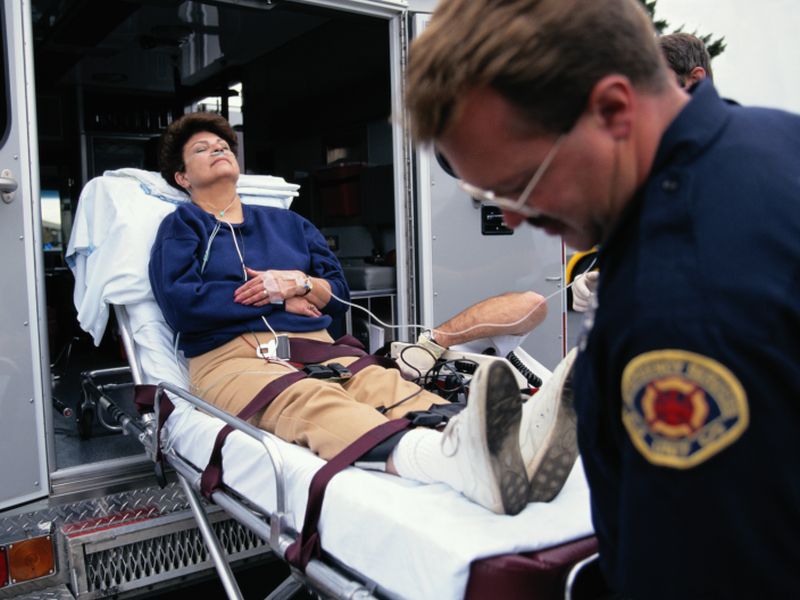When Heart Attack Strikes, Women Often Hesitate to Call for Help
By Amy NortonHealthDay Reporter

TUESDAY, Dec. 11, 2018 (HealthDay News) -- Women often delay calling for emergency help when heart attack symptoms start, a new study finds.
Researchers in Switzerland found that women suffering a heart attack typically waited 37 minutes longer than men before calling an ambulance. And those delays showed no signs of improving over the 16-year study period.
One reason may be the persistent myth that heart attacks are a "man's disease," said lead researcher Dr. Matthias Meyer, a cardiologist at Triemli Hospital, in Zurich.
In addition, he said, women are more likely than men to suffer lesser-known heart symptoms, like pain in the back, shoulder or stomach. That means many women -- and the people who witness their symptoms -- may not immediately realize they should call for help, Meyer said.
Yet, the study found, even when women had the "classic" heart attack symptom of chest pain, they often hesitated to call for help.
And while the findings come from Switzerland, a similar pattern has been seen in other countries, too, according to Dr. Suzanne Steinbaum, a spokesperson for the American Heart Association (AHA).
Steinbaum pointed to a recent research review finding that, overall, women waited 30 percent longer than men to call for help.
"That tells us this is a worldwide problem," said Steinbaum, who directs the women's cardiovascular prevention, health and wellness program at Mount Sinai Hospital in New York City.
She agreed with Meyer on the potential reasons, and also noted that many women are simply used to putting their families first, and their own health second. So even when they have symptoms like chest pain, she said, women may often take a "Let's see what happens" attitude.
For the study, Meyer's team analyzed records from nearly 4,400 heart attack patients treated at their hospital between 2000 and 2016.
The good news: Over the years, ambulance crews and hospital staff got patients into treatment faster, and the improvement was equal for women and men.
The bad news: By 2016, women were still spending 41 minutes longer in "ischemia" -- a reduction in the flow of blood and oxygen to the heart. And that was largely due to delays in calling emergency services, the researchers found.
Heart attacks occur when a clot obstructs blood flow to the heart. The quicker doctors can restore that blood flow, the less damage there will be to the heart muscle.
"There's a saying, 'Time is muscle,' " Steinbaum said.
Over the years, the AHA and its counterparts in other countries have launched public campaigns to raise women's awareness of heart disease. Yet the new study found that women were waiting just as long to call for help in 2016 as they were in 2000.
In contrast, men were slightly quicker to seek help by the end of the study -- about 6 minutes, typically.
Meyer said it's not surprising that the delays among women failed to change, but it is disappointing.
Steinbaum added, "We've clearly got more work to do. We've got to keep this conversation going."
According to the AHA, cardiovascular disease is the top killer of U.S. women, causing about one out of every three deaths.
As with men, chest pain is the most common heart attack symptom among women, the AHA says. But other symptoms include shortness of breath; pain in the back, jaw or stomach; and nausea or lightheadedness. And women are more likely than men to have those subtler problems.
"If you have those symptoms, act on them," Steinbaum said. "Call 911."
If it turns out you really have bad heartburn, she added, that's good -- you'll get to go home.
Sometimes, Steinbaum noted, people worry about "bothering" ER doctors and nurses with non-serious problems.
"You're not bothering us," she said. "That's our job."
The study was published online Dec. 11 in the European Heart Journal: Acute Cardiovascular Care.
More information
The AHA's Go Red For Women campaign has more on women and heart disease.

The news stories provided in Health News and our Health-E News Newsletter are a service of the nationally syndicated HealthDay® news and information company. Stories refer to national trends and breaking health news, and are not necessarily indicative of or always supported by our facility and providers. This information is provided for informational and educational purposes only, and is not intended to be a substitute for medical advice, diagnosis, or treatment.

